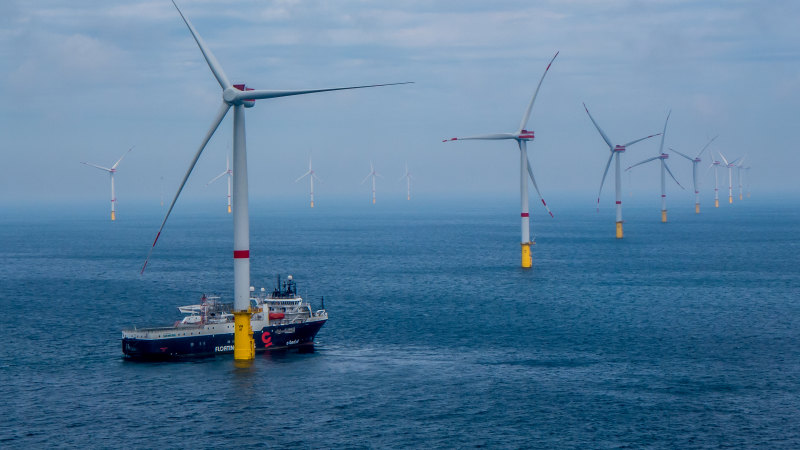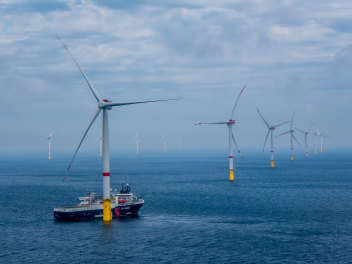Save articles for later
Add articles to your saved list and come back to them any time.
About 200 kilometres of Southern Ocean coastline could be unlocked to become an offshore wind farm zone stretching from Warrnambool in Victoria to Port MacDonnell in South Australia – potentially creating 3000 ongoing jobs in the region.
Energy Minister Chris Bowen says the proposed zone would apply to 5100 square kilometres offshore, including near Portland, which is home to one of the country’s largest smelters and draws on significant amounts of electricity.
The federal government wants to open up more than 5000 square kilometres in the Southern Ocean for wind farming.
Any turbines operating within the wind farm zone would be at least 10 kilometres from shore. Public consultation on the proposed zone opens on Wednesday and will run until August 31.
Bowen said the zone was large enough to generate renewable energy to power 8.4 million homes, and to create 3000 construction jobs and 3000 ongoing jobs.
“Powering these South Australian and Victorian communities with cheaper, cleaner energy will support them to unlock new regional job opportunities in energy and manufacturing,” he said.
“This area is an ideal location for offshore electricity generation and could enable up to 14GW of offshore wind to be developed, which is the equivalent of powering up to 8.4 million homes.”
The government has identified six regions with the potential for offshore wind farms across the country. As well as the Southern Ocean proposed zone, it has identified Gippsland (the most advanced site), the Hunter, the Illawarra, northern Tasmania and Perth/Bunbury.
Grattan Institute director Tony Wood said that generally speaking, offshore wind farms had advantages over onshore wind farm developments.
“They’re further away, and they don’t intrude into your constant field of view,” he said.
“I think that the more tricky issues for governments are going to be how they deal with the onshore component of connecting these things to the actual grid.”
He said another key advantage of offshore wind farms was they were exposed to more consistent wind than onshore farms, and therefore had more capacity to generate power.
“What makes a big difference to the economics of a wind turbine is if you go from being able to produce electricity 30 per cent to 40 per cent of the time; it makes a huge difference.”
Offshore wind farms have been seen to be less politically risky than onshore wind farms, but have still attracted local opposition.
The federal government removed the South Gippsland region from Australia’s first major offshore wind farm zone in Gippsland last year, after a campaign against the proposed farm’s proximity to Wilsons Promontory National Park.
Bowen announced in December the Gippsland zone would instead stretch from Orbost to south-east of Wilsons Prom, and said turbines would be installed 10 kilometres from the shore between Orbost and Port Albert rather than the five kilometres initially envisaged under the plan.
Turbines in the Southern Ocean zone would also be at least 10 kilometres from shore.
At state and federal levels, planning for the Southern Ocean wind farm zone has been underway for months.
In March, the Andrews government released an Offshore Wind Implementation Statement which said VicGrid – the body within the Department of Energy, Environment and Climate Action responsible for delivering renewable energy zones – expected to announce “specific transmission connection point locations and high-level route corridors in Gippsland and Portland in late 2023”.
Victorian Energy Minister Lily D’Ambrosio welcomed the addition of a second offshore wind zone in Victoria.
“Victoria is blessed with rich renewable sources, including our windy coastlines, [and] this will help us achieve our renewable energy target of 95 per cent by 2035,” she said.
Communities living along the affected coastline have been invited to take part in consultation sessions running in Warrnambool, Port Fairy, Portland, Mount Gambier and Port MacDonnell between August 1 and August 3. The public consultation period will run from June 28 to August 31.
For more information on the Southern Ocean offshore electricity area public consultation, visit https://consult.dcceew.gov.au/oei-southern-ocean
Get to the heart of what’s happening with climate change and the environment. Our fortnightly Environment newsletter brings you the news, the issues and the solutions. Sign up here.
Most Viewed in Politics
From our partners
Source: Read Full Article



